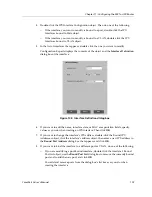
Chapter 11: Configuring the SSR for IPX Routes
160
CoreWatch User’s Manual
The SSR uses IPX RIP to create and maintain a database of internetwork routing
information. The SSR's implementation of RIP allows the following exchanges of
information:
•
Workstations locate the fastest route to a network number by broadcasting a route
request.
•
Routers request routing information from other routers to update their own internal
tables by broadcasting a route request.
•
Routers respond to route requests from workstations and other routers.
•
Routers perform periodic broadcasts to make sure that all other routers are aware of
the internetwork configuration.
•
Routers perform broadcasting whenever they detect a change in the internetwork
configurations.
SSR’s RIP implementation follows the guidelines given in Novell's
IPX RIP and SAP
Router Specification Version 1.30
document.
On the SSR, RIP automatically runs on all IPX interfaces. The SSR will keep multiple
routes to the same network having the lowest ticks and hop count. Static routes can be
configured on the SSR using the CLI’s
ipx add route
command. Through the use of RIP
filters, the SSR can control the acceptance and advertisement of networks per interface.
When creating or modifying interfaces, you should realize that interfaces bound to a
single port go down when the port goes down but interfaces bound to a VLAN remain up
as long as at least one port in that VLAN remains active. The following table summarizes
this:
Each IPX interface can be bound to a MAC address as discussed in the
SmartSwitch Router
Command Line Interface Reference Manual
. Binding an interface to a MAC address is
optional. If an interface is not bound to a MAC address, the interface uses the system
address.
If
Then
The port of a port-bound interface goes
down
The interface bound to that port also goes
down
At least one port of a VLAN remains
active
The interface bound to the VLAN remains
active
All the ports of a VLAN go down
The interface bound to the VLAN also
goes down
Summary of Contents for SSR-GLX19-02
Page 1: ...CoreWatch User s Manual 9032564 04...
Page 2: ...Notice 2 CoreWatch User s Manual...
Page 20: ...Preface 20 CoreWatch User s Manual...
Page 64: ...Chapter 5 Changing System Settings 64 CoreWatch User s Manual...
Page 86: ...Chapter 6 Configuring SSR Bridging 86 CoreWatch User s Manual...
Page 106: ...Chapter 7 Configuring VLANs on the SSR 106 CoreWatch User s Manual...
Page 206: ...Chapter 12 Configuring QoS on the SSR 206 CoreWatch User s Manual...
Page 246: ...Chapter 13 Configuring Security on the SSR 246 CoreWatch User s Manual...
Page 363: ...CoreWatch User s Manual 363 Chapter 16 Configuring Routing Policies on the SSR 9 Click OK...
Page 364: ...Chapter 16 Configuring Routing Policies on the SSR 364 CoreWatch User s Manual...
Page 370: ...Chapter 17 Checking System Status 370 CoreWatch User s Manual...
Page 390: ...Chapter 18 Monitoring Real Time Performance 390 CoreWatch User s Manual...
Page 396: ...Chapter 19 Checking the Status of Bridge Tables 396 CoreWatch User s Manual...
Page 430: ...Chapter 20 Checking the Status of Routing Tables 430 CoreWatch User s Manual...
Page 442: ...Chapter 22 Obtaining Reports 442 CoreWatch User s Manual...
Page 456: ...Appendix B CoreWatch Menus 456 CoreWatch User s Manual...
















































